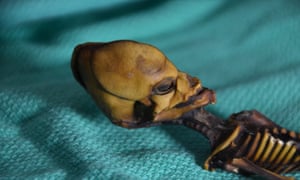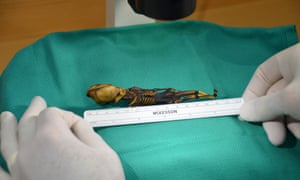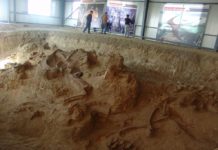Genetic tests reveal tragic reality of Atacama ‘alien’ skeleton
Ian Sample Science editor
Mummified remains from Chilean ghost town revealed to be baby girl with malformations so bizarre they led to speculation over alien life.

The mummified skeleton of a baby girl found in the Chilean desert in 2003. Photograph: Dr Emery Smith
When the mummified remains of a six-inch humanoid were found in an abandoned mining town in Chile’s Atacama desert 15 years ago, speculation on its origins ran wild. The skeleton, which was sold to a private collector in Spain, was so bizarre it appeared in a documentary as potential evidence for alien life.
Now scientists in California have extracted DNA from the mummy’s bones and pieced together the real and tragic story of the individual, known as Ata. Rather than a visitor from another world, Ata was a girl who appears to have been stillborn, or to have died immediately after birth, with devastating mutations that shaped her extraordinary body.
Ata’s remains were found in 2003 in La Noria, an old nitrate-mining town, reportedly wrapped in white cloth tied with a violet ribbon. The skeleton was remarkable in many ways. While only six inches tall, the bones had some features of a child aged six to eight. Instead of the usual 12 pairs of ribs found on humans, Ata had only 10 pairs. The head was an elongated cone shape.
The curious remains caught the eye of Garry Nolan, a professor of microbiology and immunology at Stanford University in California, who offered to study the specimen. In 2013, he concluded that Ata was human, but the reasons for the dramatic deformities were far from clear.
Nolan and his colleagues at the University of California in San Francisco have now published their analysis of Ata’s full genetic makeup. From DNA extracted from the bones, they found that Ata was a girl who carried mutations in at least seven genes that are known to cause major skeletal malformations or accelerate their development. Taken together they explain Ata’s size, abnormal ribs and skull shape, and the apparently advanced age of her bones. Beyond her skeletal malformations, Ata may have had a condition called congenital diaphragmatic hernia, a relatively common life-threatening birth defect in which the diaphragm does not develop properly. Further analysis found that Ata’s DNA most closely resembled that of other Chileans.











